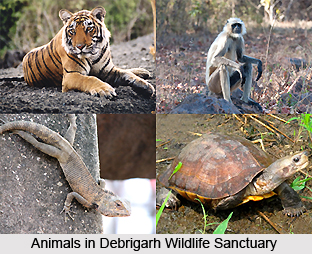 Debrigarh Wildlife Sanctuary is a 347 sq km wildlife reserve located in the pleasing atmosphere of the Hirakud Dam in the Indian state of Orissa. Debrigarh Wildlife Sanctuary is situated around 40km from Sambalpur in Baragarh District of Orissa. The area is pregnant with lush green vegetation and consists of numerous species of birds and animals. The sanctuary, which stretches across the Lohara and Debrigarh Reserve forests on the Barapahad hills in the district of Baragarh is covered with mixed deciduous forest, attracts several visitors through out the year. Moreover, the waterfalls, during the monsoon, also provide a pleasing sight to the tourists. Debrigarh, bordered by the Lambipalli, Jhagadabehera, and Mundakati villages, encloses the Lakhanpur and Kamgaon wild life ranges. The prime attractions of Debrigarh are the scenic surroundings, wild animals and migratory birds, ancient caves and rock paintings, stunning waterfalls and adventurous trekking routes.
Debrigarh Wildlife Sanctuary is a 347 sq km wildlife reserve located in the pleasing atmosphere of the Hirakud Dam in the Indian state of Orissa. Debrigarh Wildlife Sanctuary is situated around 40km from Sambalpur in Baragarh District of Orissa. The area is pregnant with lush green vegetation and consists of numerous species of birds and animals. The sanctuary, which stretches across the Lohara and Debrigarh Reserve forests on the Barapahad hills in the district of Baragarh is covered with mixed deciduous forest, attracts several visitors through out the year. Moreover, the waterfalls, during the monsoon, also provide a pleasing sight to the tourists. Debrigarh, bordered by the Lambipalli, Jhagadabehera, and Mundakati villages, encloses the Lakhanpur and Kamgaon wild life ranges. The prime attractions of Debrigarh are the scenic surroundings, wild animals and migratory birds, ancient caves and rock paintings, stunning waterfalls and adventurous trekking routes.
The inner regions of Debrigarh Wildlife Sanctuary houses various animals like Tiger, Sloth Bear, Leopard, Spotted Deer, Antelopes, Sambar, Chousingha, Gaur, Langur Monkeys and Monitor Lizard. Moreover, several migratory birds travel vast distances to take shelter in the dense forest.
The Divisional headquarters of Debrigarh Sanctuary is at Sambalpur, which is 317 Km from Bhubaneshwar, the State Capital, located on the NH-42 and NH-6. The region of Sambalpur is properly connected by Rail to Kolkata, Delhi, Chennai and Mumbai, as well as rest of India. The wildlife reserve has two entrances, Lakhanpur in the North and Dhodrokusum, in the south. Bus services are available regularly from Lakhanpur and Pahadsirgida, for the convenience of the travellers. The Sanctuary is located in the Chota Nagpur region of Deccan Peninsula Bio-geographic zone. Debrigarh sanctuary is located almost 60 km from Baragarh and 40 km from Sambalpur.
Flora and Fauna of Debrigarh Wildlife Sanctuary
Debrigarh Wildlife Sanctuary spread over 347 sq km, offers a stunning panorama of varied flora and fauna. Due to the extended dry season and short monsoon period, the forest type of the sanctuary is mainly mixed dry deciduous forest. Other varieties of trees found here are Sal, Asana, Bija, Aanla, Dhaura etc. a huge variety of wild animals reside in the dense forest of the sanctuary, such as Tiger, Sloth Bear, Leopard, Hyena, Spotted Deer, Antelopes, Sambar, Gaur, Nilgai, Bison, Langur Monkeys, Chameleon, Mugger Crocodile, Freshwater Turtle and Monitor Lizards. Moreover, several migratory birds travel vast distances to take shelter in the dense forest.
Furthermore, a number of resident and migratory birds such as the Chousingha and the Crested Serpent Eagle are also found in the pleasing topography. The gorgeous birds increase the beauty of the sanctuary making the environment more sparkling and splendid. The Hirakud dam lying near the sanctuary attracts numerous traveling birds especially in winters.
Tourism of Debrigarh Wildlife Sanctuary
The unexplored and virgin natural beauty of Debrigarh Wildlife Sanctuary attracts numerous tourists to this location. Moreover the Hirakud Reservoir gives a panoramic view of the lush green surroundings. Convenient accommodation facilities are available for the visitors in the Forest Rest Houses in Dechua and Dhodrokusum, and also small Cottages at Chaurasimal.
The visitors can enjoy the pristine beauty of the reserve and go for animal sighting by using protected vehicles, provided by the authorities. Moreover, boat rides are also provided to the travellers on the Hirakud Reservoir, so that they can enjoy the swamped islands and sunken temple heads.
The forests also provide good opportunities for adventure enthusiasts. There are adequate trekking and nature trails that have been developed for real eco-tourists. The best time to visit Debrigarh Sanctuary is from November to June.











